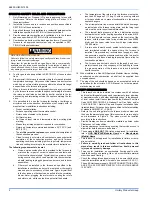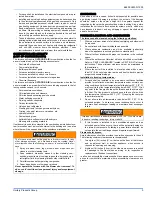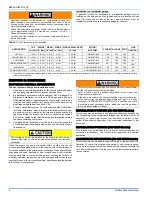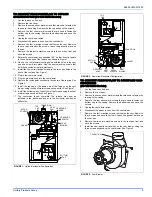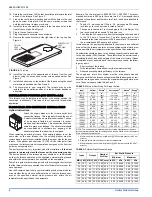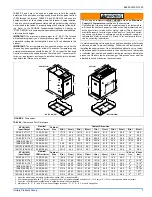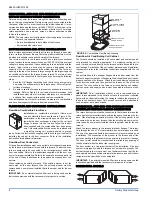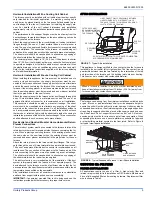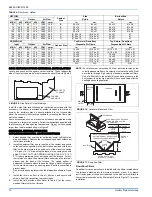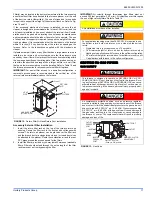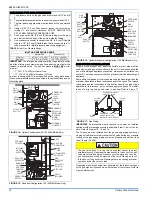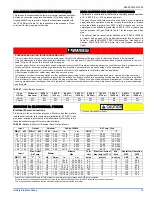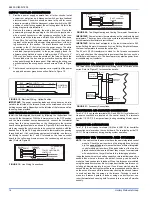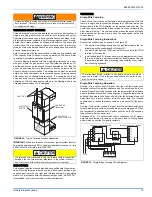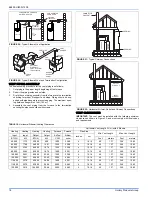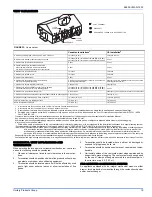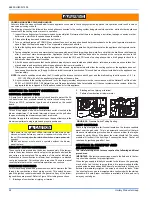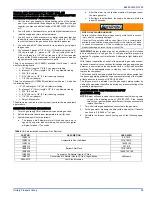
66832-UIM-D-1205
Unitary Products Group
9
Horizontal Installations With a Cooling Coil Cabinet
The furnace should be installed with coil cabinet part number specifi-
cally intended for Horizontal application. If a matching cooling coil is
used, it may be placed directly on the furnace outlet and sealed to pre-
vent leakage. Follow the coil instructions for installing the supply ple-
num. For details of the coil cabinet dimensions and installation
requirements, refer to the installation instructions supplied with the coil
cabinet
The perforations in the wrapper flanges must be bent away from the
heat exchanger to create duct flanges so the air conditioning coil can be
properly seated on the furnace.
Attach the supply plenum to the air conditioning coil cabinet outlet duct
flanges through the use of S cleat material when a metal plenum is
used. The use of an approved flexible duct connector is recommended
on all installations. The connection to the furnace, air conditioning coil
cabinet and the supply plenum should be sealed to prevent air leakage.
The sheet metal should be crosshatched to eliminate any popping of
the sheet metal when the indoor fan is energized.
The minimum plenum height is 12” (30.5 cm). If the plenum is shorter
than 12” (30.5 cm) the turbulent air flow may cause the limit controls not
to operate as designed, or the limit controls may not operate at all. Also
the plastic drain pan in the air conditioning coil can overheat and melt.
Refer to the installation instructions supplied with the air conditioning
coil for additional information.
Horizontal Installations Without a Cooling Coil Cabinet
When installing this appliance, the furnace must be installed so as to
create a closed duct system, the supply duct system must be con-
nected to the furnace outlet and the supply duct system must terminate
outside the space containing the furnace. When replacing an existing
furnace, if the existing plenum is not the same size as the new furnace
then the existing plenum must be removed and a new plenum installed
that is the proper size for the new furnace.
Attach the supply plenum to the furnace outlet duct flanges through the
use of S cleat material when a metal plenum is used. The use of an
approved flexible duct connector is recommended on all installations.
This connection should be sealed to prevent air leakage. The sheet
metal should be crosshatched to eliminate any popping of the sheet
metal when the indoor fan is energized. On all installations without a
coil, a removable access panel is recommended in the outlet duct such
that smoke or reflected light would be observable inside the casing to
indicate the presence of leaks in the heat exchanger. This access cover
shall be attached in such a manner as to prevent leaks.
Residential and Non Hud Modular Home Horizontal Return
Plenum Connections
The return duct system must be connected to the furnace inlet and the
return duct system must terminate outside the space containing the fur-
nace. When replacing an existing furnace, if the existing plenum is not
the same size as the new furnace then the existing plenum must be
removed and a new plenum installed that is the proper size for the new
furnace.
Attach the return plenum to the furnace inlet duct flanges. This is typi-
cally through the use of S cleat material when a metal plenum is used.
The use of an approved flexible duct connector is recommended on all
installations. The connection of the plenum to the furnace and all the
ducts connecting to the plenum must be sealed to prevent air leakage.
The sheet metal should be crosshatched to eliminate any popping of
the sheet metal when the indoor fan is energized.
The duct system is a very important part of the installation. If the duct
system is improperly sized the furnace will not operate properly. The
ducts attached to the furnace must be of sufficient size so that the fur-
nace operates at the specified external static pressure and within the air
temperature rise specified on the nameplate.
Attic installations must meet all minimum clearances to combustibles
and have floor support with required service accessibility.
IMPORTANT: if an external mounted filter rack is being used see the
instructions provided with that accessory for proper hole cut size.
ATTIC INSTALLATION
This appliance is design certified for line contact when the furnace is
installed in the horizontal left or right position. The line contact is only
permissible between lines that are formed by the intersection of the top
and two sides of the furnace and the building joists, studs or framing.
This line may be in contact with combustible material.
SUSPENDED FURNACE / CRAWL SPACE
INSTALLATION
The furnace can be hung from floor joists or installed on suitable blocks
or pad. Blocks or pad installations shall provide adequate height to
ensure the unit will not be subject to water damage. Units may also be
suspended from rafters or floor joists using rods, pipe angle supports or
straps. Angle supports should be placed at the supply air end and near
the blower deck. Do not support at return air end of unit. All four sus-
pension points must be level to ensure quiet furnace operation. When
suspending the furnace use a secure platform constructed of plywood
or other building material secured to the floor joists. Refer to Figure 8
for typical crawl space installation.
SECTION III: FILTERS
FILTER INSTALLATION
All applications require the use of a filter. A high velocity filter and
retainer are provided for field installation on G8C models. Models must
have a field-supplied filter and mounting hardware. Replacement filter
size is shown in Table 5.
FIGURE 7: Typical Attic Installation
When a furnace is installed in an attic or other insulated space,
keep all insulating materials at least 12 inches (30.5 Cm) away from
furnace and burner combustion air openings.
FIGURE 8: Typical Suspended Furnace / Crawl Space Installation
SHEET METAL IN FRONT OF FURNACE COMBUSTION
AIR OPENINGS IS RECOMMENDED
SUPPLY
AIR
PLYWOOD
FLOOR
30” MIN.
WORK AREA
SEDIMENT
TRAP
RETURN AIR
FILTER RACK MUST
BE A MINIMUM DISTANCE
OF 18” (45.7 CM) FROM
THE FURNACE
LINE CONNECT ONLY PERMISSIBLE BETWEEN
LINES FORMED BY THE INTERSECTION OF
FURNACE TOP AND TWO SIDES AND BUILDING
JOISTS, STUDS, OR FRAMING
ANGLE IRON
BRACKET
1” MAX. BETWEEN
ROD & FURNACE
6” MIN. BETWEEN
ROD & FURNACE
1” MAX. BETWEEN
ROD & FURNACE
SUPPORT
ROD


